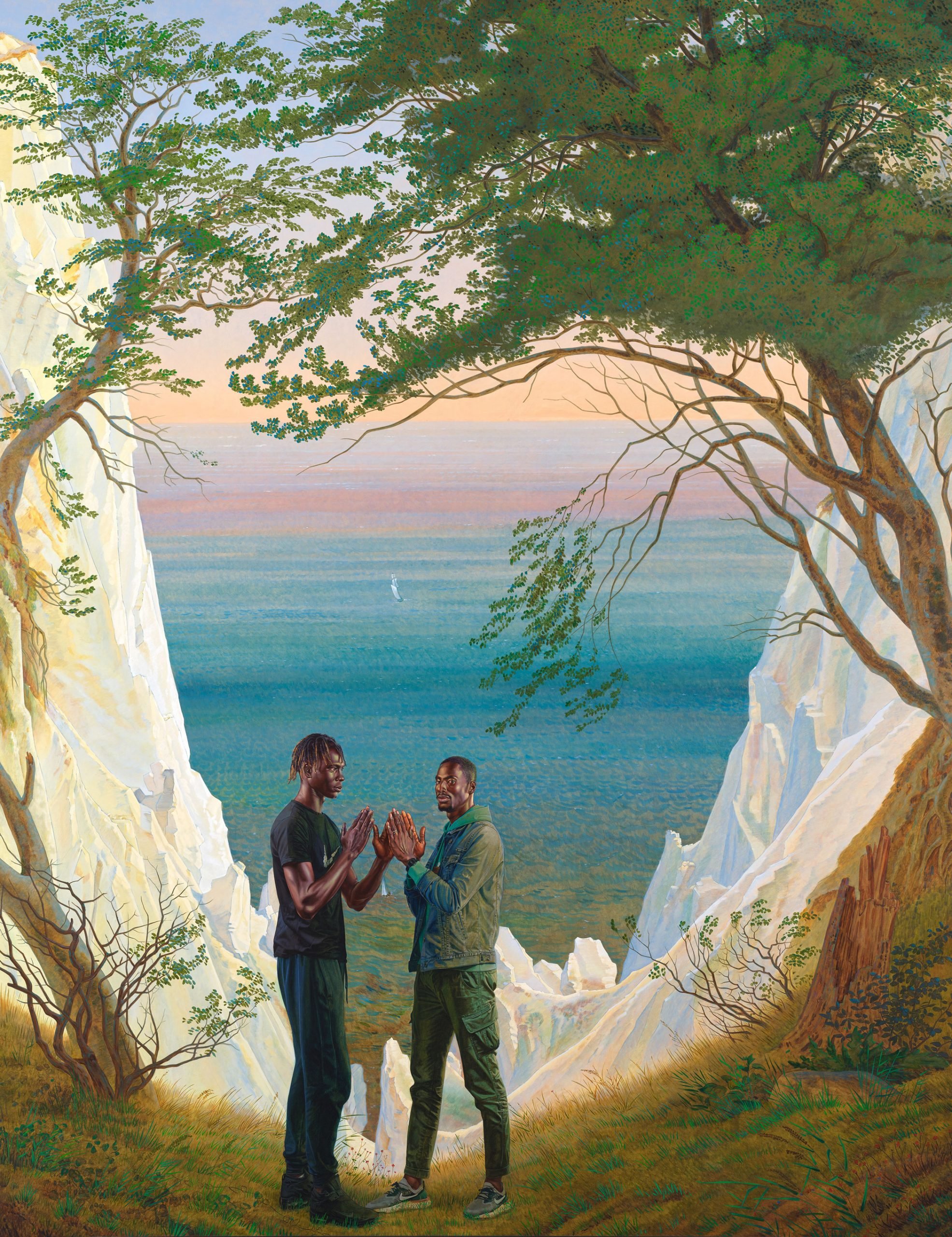
It’s a compelling classic: In Caspar David Friedrich’s The Wanderer Above the Fog (1818), a lone man on a rock gazes out over range of mountains half-blanketed in fog, his back to the viewer. His hair is tousled, he’s sharply dressed with a cane. Situated dead-center in the picture plane, the figure stands in sharp contrast to the sky and its gentle grays and whites. He’s a solitary soul contemplating the power and beauty of nature: in it, but not of it.
The painting is arguably the artist’s most famous work, a cornerstone of German Romanticism. Yet humans’ place in nature has ensnared artists since time immemorial—and a new show positions Friedrich’s timeless investigations alongside contemporary artists and his contemporaries. The major exhibition, which commemorates the 250th anniversary of Friedrich’s birth year, finds a particular relevance among today’s compounding environmental emergencies.
On view until April 1, 2024, the Hamburger Kunsthalle’s sweeping retrospective “Caspar David Friedrich: Art for a New Age” features 70 well-known paintings and more than of his 100 drawings by the 19th century artist alongside about 20 additional pieces by his contemporaries, including even his brother Christian (Boy Sleeping on a Grave, (1802). A second section dedicates itself to 20th and 21st century artists—among them Julian Charriere, Susan Schuppli, and Nina K. Jurk—whose work connects with Friedrich or embodies aspects of the humanity’s complex relationships with the natural world.
Julian Charriere The Blue Fossil Entropic Stories III (2013). Courtesy DITTRICH & SCHLECHTRIEM, Berlin © Julian Charrière / VG Bild-Kunst, Bonn 2023
Friedrich’s landscapes and remote protagonists highlighted a shifting connection to nature when he created them in the early 19th century as the Industrial Revolution was rapidly gaining traction, but the artist’s work has passed through many “new ages” since. In the late 19th and early 20th centuries, he was rediscovered and canonized as a Romantic (by the time he died in Dresden in 1840, he’d fallen from visibility). A few decades later, the movers and shakers of the Third Reich saw his work as the epitome of German-ness (unlike other painters of his era, he stayed at home in northern Germany, rather than decamping to Italy). It took until 1974 for that nationalist association to wear off: that year, his work was widely shown in Hamburg and Dresden, each on a respective side of a divided Germany. Now, in yet another new age of global climate panic, his landscape paintings and nature studies take on a different urgency.
The show opens with early self-portraits—in one, from around 1800 and done in black chalk on paper, he looks coquettishly at the viewer. Subsequent rooms move from topic to topic: Gathered in one space are Friedrich’s drawn studies of trees, thistles, rocks, leaves, and clouds, all rendered in meticulous detail. One room is all about ice: Near his The Sea of Ice (1823–24)—an aggressive painting of jagged shards of breaking river ice consuming a capsizing ship—are smaller color studies of ice fragments. Another gallery focusses entirely on Friedrichs’ paintings of ruins set in lush forests.
The artist’s greatest hits are also here in all their glory: Ice and Wanderer, of course, but also The Monk by the Sea (1808-10) which shows a lone, cloaked monk on a beach contemplating turbulent skies and water. Chalk Cliffs on Rügen (1818) frame a multicolored sea with brilliant white cliffs. Mountain Landscape with Rainbow (1809-10) sees a glimmering rainbow cut across the dark heavens. In Friedrichs’ later works human figures become scarcer and the land and sky’s undulating colors more prominent.
Caspar David Friedrich (1774–1840) Das Eismeer, (1823/24). Hamburger Kunsthalle. © Hamburger Kunsthalle/bpk. Foto: Elke Walford
The show’s contemporary section, consisting of the work of 21 artists, does a daring long jump into the present, but it’s where Friedrich’s ongoing inspiration unfolds and begins to take on new meanings. Swaantje Güntzel riffs on Friedrich by having herself photographed from the back in a series of images (Arctic Joghurt, 2. Dezember 2021) in which she throws a plastic yogurt cup into a Norwegian fjord.
Hiroyuki Masuyama’s photomontages in LED boxes are high-tech “copies” of several of Friedrich’s hits, and Olafur Eliasson’s Color Experiment no. 86, (2019), a large disc in gradated light colors, uses the exact hues in The Sea of Ice. The lush forest in David Claerbout’s Wildfire (meditation on fire) (2019/20)—a vast light box showing a computer-generated forest fire—mirror the dense foliage of Friedrich’s paintings, but here, the trees slowly burn.
David Claerbout Wildfire (meditation on fire), (2019–2020). In collaboration with Musea Brugge, courtesy of the artist and Kunstmuseum Bonn, Dauerleihgabe der KiCo Collection Bonn. © VG Bild-Kunst, Bonn 2023
The show closes with works by Kehinde Wiley: In one of two oversize paintings (The Prelude (Babacar Mené), 2021), a contemporary “wanderer” again overlooks the sky, fog, and a mountain landscape from a rocky crag; this Black figure, recalling Friedrich’s seminal work (he holds two canes), is turned just a little toward the viewer.
But it’s in Wiley’s six-channel video The Prelude (2021) that we finally see faces. Black figures wander through a snowy mountain landscape; some wear furs, others are shirtless and shivering. There’s lush music, a narration taken from William Wordsworth’s autobiographical poem “The Prelude,” and often, the protagonists stare straight into the camera.
Only here in Wiley’s art does humanity, not nature, take the central role. Beyond the artist’s ongoing disruption of art’s Eurocentric canon and his reference to colonialism’s ravages, the works seem to demand us to take responsibility for the ailing world surrounding us, so that everyone and everything can survive, and maybe even thrive.
“Caspar David Friedrich: Art for a New Age” is on view until April 1, 2024, at the Hamburger Kunsthalle in Hamburg. Additional exhibitions celebrating Caspar David Friedrich will run throughout 2024 in Berlin and Dresden.